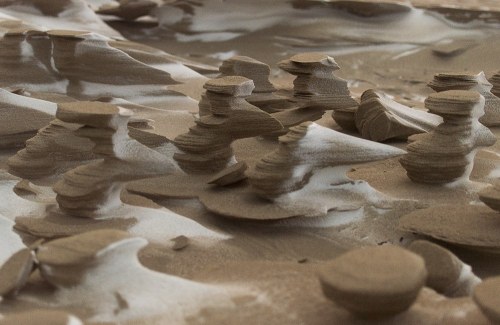Wind, ice and sand Wandering along the beaches of an icy Lake Michigan, the photographer spotted the
Wind, ice and sandWandering along the beaches of an icy Lake Michigan, the photographer spotted these foot high baby yardangs (aka hoodoos) on the normally sandy beach. Dozens of these towers were rising up over what had been a flat expanse of sand, and the life cycle of this phenomenon reveals in a few days or weeks erosional processes that take many millennia or more in rocks.The beach was frozen in the winter cold, solidifying. The ice (which is also a mineral) cemented the grains into a temporary, temperature mediated sandstone, in much the same way as calcite or silica from the waters that percolate the depths of the Earth do to sediments during their transformation into rock (a complex set of processes known as diagenesis). The howling winter winds then eroded the beach in the same way that they would a sandstone, but much faster than usual since ice is a lot softer than the usual mineral cements found in sedimentary rocks.A couple of days later (these were taken on Valentine’s day), he returned to check on them, but a rise in temperature had dissolved them all, melting their icy cement.Geological processes are fractalic as I keep on emphasising, recurring across scales from the tiny to the huge (see http://on.fb.me/1L72vp3). Yardangs many tens of metres tall exist, as do these beautiful tiddlers. This process reveals another fractalic dimension, that of motion through time. The same processes took place over a couple of days, rather than the usual millions of years.LozImage credit: Joshua Novicki.http://joshuanowicki.smugmug.com/http://earthsky.org/todays-image/wind-sculpted-this-frozen-sand-in-michiganhttp://www.thisiscolossal.com/2015/02/ice-sand-scultpures-lake-michigan/ -- source link
Tumblr Blog : the-earth-story.com
#erosion#lake michigan#nature#science#yardang#geology#fractal#hoodoo

